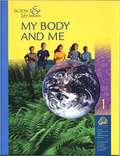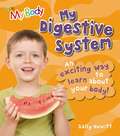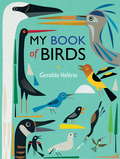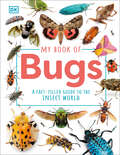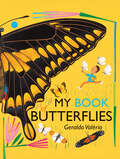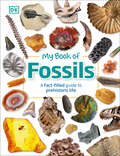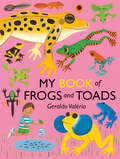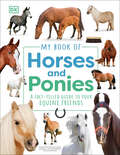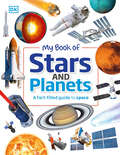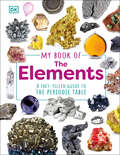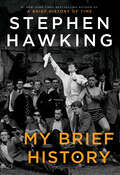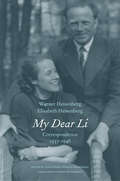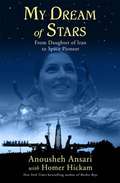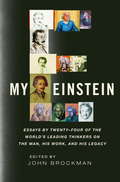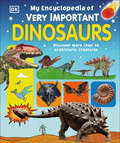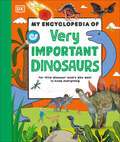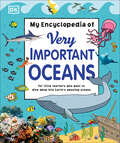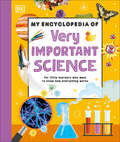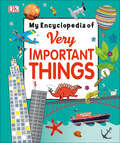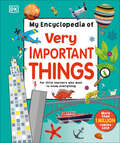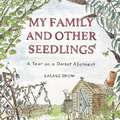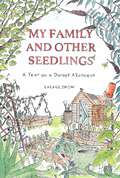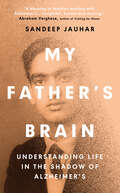- Table View
- List View
My Body and Me (Science and Life Issues)
by Lab-AidsAs you examine the activities in this book, you may wonder, "Why does this book look so different from other science books I've seen?" The reason is simple: it is a different kind of science program, and only some of what you will learn can be seen by leafing through this book!
My Body: My Digestive System
by Sally HewittCovering the key body systems, this series provides an essential introduction to how the human body works. Packed with photographs, artwork and clear, concise text, these titles make complex ideas easy to understand. This title features: labelled diagrams of key body parts; activities to aid understanding; and, fascinating facts, written and checked by experts.
My Body: My Eyes
by Kathy FurgangExplains the parts of our eyes, how they allow us to see in color and darkness, the importance of good vision, and various eye problems.
My Book of Birds
by Geraldo Valerio"An enchanting book" Joanna Lumley"Full of amazing facts and beautiful clear illustrations. A book to inspire the young and indeed the old!" Alison Steadman"Will not fail to ignite young imaginations" David LindoFull of stunning illustrations and incredible facts, My Book of Birds is a glorious celebration of birds. From majestic golden eagles and snowy owls to brilliant red crossbills and puffins to the tiniest of hummingbirds, the book covers them all. Meet cormorants that can dive underwater for up to 30 seconds at a time, and ptarmigans whose feathers turn completely white in winter, so they can blend in with their snowy habitat. Beautifully designed, and with a debossed wibalin cover, this is an ideal gift for bird lovers of all ages! If you've loved Beautiful Birds, or The Genius of Birds, or Bill Bailey's Remarkable Guide to British Birds, then you'll love this. Incredible collage illustrations from Geraldo Valério show a variety of feathered creatures in their natural habitats as they hunt for food, impress their mates, nest and care for their young. The concise, accessible text is ideal for children aged six and above, and provides information ranging from clever techniques for finding food to remarkable physical features to fascinating behaviours. But above all, Geraldo Valério shares his passion for birds in this lovingly created album, inspiring young readers with their beauty and the excitement of discovery.Includes an introduction, glossary, index and sources for further information.
My Book of Bugs: A Fact-Filled Guide to the Insect World (My Book of)
by DKLearn all about the fascinating world of insects—from bees, to butterflies, beetles, and more.Grab your magnifying glass and head out to discover all about insects— their different types, body structures, and behaviors. Filled with eye-catching images and bite-sized information, every young nature enthusiast will marvel at the mind-boggling facts about these adaptable creatures. The book covers the seven major insect groups and includes profiles for more than 40 amazing insects, such as the stag beetle, monarch butterfly, and honeybee.Dive into their brilliant world and learn how some insects blend in with their surroundings. Discover how some can survive in different environments, while others can defend themselves against predators using clever tactics. Explore the many ways in which insects help humans, and the crucial role they play in pollination and maintaining a balance in the ecosystem.My Book of Bugs is a wonderful introduction to insects and their many incredible features. This book will not just teach children about fascinating insects but will also make them understand and respect the environment.
My Book of Butterflies
by Geraldo ValérioThis stunning exploration of butterflies from around the world is a companion to My Book of Birds Geraldo Valério grew up in Brazil, watching white butterflies visit the vegetable patch behind his house. As he got older, he learned more about these unique and beautiful insects, which can be found on every continent except Antarctica. In this gorgeous album, Geraldo presents his favorite butterfly species from around the world. Paint and paper collage illustrations show the butterflies in flight, sipping nectar, laying eggs and resting among flowers and foliage. The text provides fascinating information about each species — from familiar Monarchs and Giant Swallowtails, to dazzling Blue Morphos and tiny Snowflakes, from beautifully patterned European Peacocks to endangered Queen Alexandra’s Birdwings. Colorful endpapers, showing the butterflies as caterpillars and chrysalides, complete this beautiful book for budding young naturalists. Includes an introduction, world map, fully illustrated spreads showing a butterfly’s life cycle and body parts, as well as a glossary, index and suggestions for further reading. Key Text Features scientific illustrations introduction further information foreword author's note facts scientific nomenclature scientific illustrations map additional information captions glossary index labels Correlates to the Common Core State Standards in English Language Arts: CCSS.ELA-LITERACY.RI.K.1 With prompting and support, ask and answer questions about key details in a text. CCSS.ELA-LITERACY.RI.K.4 With prompting and support, ask and answer questions about unknown words in a text. CCSS.ELA-LITERACY.RI.K.7 With prompting and support, describe the relationship between illustrations and the text in which they appear (e.g., what person, place, thing, or idea in the text an illustration depicts).
My Book of Fossils: A fact-filled guide to prehistoric life (My Book of)
by DK Dean R. LomaxUnearth hidden fossils and unleash a new love for all things prehistoric!Learn about the world&’s primeval past through its fascinating and wonderful world of fossils. From glistening seashells and mammoth dinosaur teeth to delicate colorful flora, uncover a magnitude of treasures left behind to better understand our primitive past.This intriguing fact-filled guide into ancient times will have you learning about where fossils come from and where they have been found. This primal book about earliest life includes: • A definitive guide to fossils, featuring 50 profiles of the most incredible discoveries in paleontology • A science-focused and fact-packed route into learning about prehistoric life • Top-quality photography to show fossils in fine detail and highlight key features • Age-appropriate with large pictures and clear text • Pronunciation guide for each fossil animal or plant name • Fact files for each featured fossil give the key information, such as size, time period and location This engrossing children's book about fossils and dinosaurs is filled with all you need to know about ancient fossils as well as how to contain recently discovered species. It will help even the biggest fossils fans learn something brand new! This prehistoric book contains remarkably phenomenal photographs that can be studied in detail, as well as pronunciation guides to help with those tricky names.Displayed into plants and animals, there are 50 key fossil profiles, including the beloved favorite dinosaur Triceratops and a magnitude of other remains, like fossil fish teeth. An easy-to-follow visual index provides a quick overview of all the key species in the book, so you can be well on your way to becoming a fossil expert.This is the perfect book for children ages 5 to 7 with a love of fossils and dinosaurs, as well as parents, caregivers and teachers who want a reliable introductory book to fossils and prehistoric life!
My Book of Frogs and Toads (Big Books for Little Naturalists)
by Geraldo ValérioLeap into this stunning exploration of frogs and toads from around the world! A companion to My Book of Butterflies and My Book of Birds. When Geraldo Valério was growing up in Brazil, he learned that the tiny creatures he saw swimming in a puddle by the river weren’t fish, but tadpoles that would grow and change into entirely different creatures … and his fascination with frogs and toads began! In this gorgeous album, Geraldo presents his favorite frog and toad species from around the world. Dazzling paint and paper collage illustrations introduce us to a wide range of creatures: meet the frog who can grow to the size of a small housecat, and the toad who spends most of its life in an underground burrow. Learn fascinating frog and toad facts about what they like to eat, how they grow and reproduce and why one particular toad smells like garlic! Colorful endpapers, showing the frogs and toads as eggs and tadpoles, complete this beautiful book for budding young naturalists. Includes an introduction, world map, a diagram of a frog and toad’s life cycle, a chart explaining the differences between frogs and toads, as well as a glossary, index and suggestions for further reading. Key Text Features scientific illustrations introduction further information foreword author's note facts scientific nomenclature scientific illustrations map additional information captions glossary index labels Correlates to the Common Core States Standards in English Language Arts: CCSS.ELA-LITERACY.RI.K.1 With prompting and support, ask and answer questions about key details in a text. CCSS.ELA-LITERACY.RI.K.3 With prompting and support, describe the connection between two individuals, events, ideas, or pieces of information in a text. CCSS.ELA-LITERACY.RI.K.5 Identify the front cover, back cover, and title page of a book. CCSS.ELA-LITERACY.RI.K.7 With prompting and support, describe the relationship between illustrations and the text in which they appear (e.g., what person, place, thing, or idea in the text an illustration depicts). CCSS.ELA-LITERACY.RI.K.9 With prompting and support, identify basic similarities in and differences between two texts on the same topic (e.g., in illustrations, descriptions, or procedures). CCSS.ELA-LITERACY.RI.1.5 Know and use various text features (e.g., headings, tables of contents, glossaries, electronic menus, icons) to locate key facts or information in a text. CCSS.ELA-LITERACY.RI.1.9 Identify basic similarities in and differences between two texts on the same topic (e.g., in illustrations, descriptions, or procedures).
My Book of Horses and Ponies: A Fact-Filled Guide to Your Equine Friends (My Book of)
by DKAn exciting first guide to the magnificent world of horses.Learn all about horses, from how to care for them to how to ride one, in this informative children&’s guide to horse and pony care.Covering favorite breeds, from Shire horse to Shetland pony, what kit to use, and equestrian sports, this visual book is something that every young horse enthusiast aged 5-7 will want to own. Eye-catching images are featured alongside friendly illustrations, giving children plenty to take in and enjoy.This informative horse book for children offers:- Clear and accessible text on horse care and characteristics using annotations, friendly language, and a clear structure.- Fact files on more than 20 breeds, with top-trump style comparisons and digestible information.- An introduction to new and interesting information in this successful series for young learners.My Book of Horses and Ponies is an engaging and informative children's book, with age-appropriate text, photographs, and illustrations on every page. Young equine enthusiasts will be excited to read this wonderful treasury of horses and ponies.Complete the seriesThis engaging guide to horse breeds is part of the My Book of series of educational books for children. Whatever your subject, why not complete the series with My Book of Cats and Kittens, My Book of Dogs and Puppies, My Book of Rocks and Minerals, My Book of the Elements, My Book of Stars and Planets, and My Book of Fossils?
My Book of Stars and Planets: A fact-filled guide to space (My Book of)
by Parshati PatelJoin us on an adventure across the universe, as we rocket to the stars, marvel at mysterious planets and discover galaxies far far away. Three, two, one, blast off! From icy worlds and hot, fiery giants to the biggest telescopes and latest spacecraft, this book about space covers more than 40 profiles of the planets, stars and celestial objects.This out-of-this-world astronomy book for kids is packed with: • Age-appropriate with large pictures and clear text. • Pronunciation guide for each planet and astronomical object. • Visual index arranged by type, so stars and planets can be found quickly. • Fact files for each featured object give key information, like size, type of object and location in the universe. Tapping into children's natural curiosity about the vastness of space, this stunning encyclopedia will enchant every budding astronaut. Did you know that our Solar System is part of a galaxy called the Milky Way? Or that Saturn is the furthest planet that can be seen from Earth without a telescope? You&’ll discover many fascinating facts about our neighboring planets and the latest space technology!Broken down by type, each object is presented in a clear, engaging way, with stunning images and bite-sized chunks of information. Young stargazers will be intrigued by the detailed NASA photography that brings the mysteries of outer space down to Earth! The handy pronunciation guide helps with tricky names and a visual index gives a quick overview of all the key objects in this reference book.My Book of Stars and Planets is the perfect gift for kids ages 5-8 who are interested in learning about the universe.
My Book of the Elements: A Fact-Filled Guide to the Periodic Table (My Book of)
by Adrian DingleLearn about the elements that make up our world and the science that defines them.My Book of the Elements is a wonderful introduction to the periodic table for children aged 5-7 who are interested in all things chemistry.Covering all the elements, from the unreactive to the radioactive, as well as key science topics, such as states of matter, this visual book is something that every young science enthusiast will want to own. Eye-catching images are featured alongside friendly illustrations, giving children plenty to take in and enjoy.This informative chemistry book for children offers:- Clear and accessible text, on a subject that is traditionally difficult, using friendly language and a clear structure.- Fact files provided for each element, with top-trump style comparisons and digestible information.- An introduction to new and interesting information in this successful series for young learners.Written by an expert author, this series is a source of information you can trust, with age-appropriate text and material that supports your child&’s schoolwork. From Hydrogen to Oganesson, each element is explored in detail, with information on properties and use cases, as well as fun facts.Complete the seriesThis engaging guide on the elements is part of the My Book of series of educational books for children. Whatever your subject, why not complete the series with My Book of Cats and Kittens, My Book of Dogs and Puppies, My Book of Rocks and Minerals, My Book of Stars and Planets and My Book of Fossils?
My Brief History
by Stephen HawkingStephen Hawking has dazzled readers worldwide with a string of bestsellers exploring the mysteries of the universe. Now, for the first time, perhaps the most brilliant cosmologist of our age turns his gaze inward for a revealing look at his own life and intellectual evolution. My Brief History recounts Stephen Hawking's improbable journey, from his postwar London boyhood to his years of international acclaim and celebrity. Lavishly illustrated with rarely seen photographs, this concise, witty, and candid account introduces readers to a Hawking rarely glimpsed in previous books: the inquisitive schoolboy whose classmates nicknamed him Einstein; the jokester who once placed a bet with a colleague over the existence of a particular black hole; and the young husband and father struggling to gain a foothold in the world of physics and cosmology. Writing with characteristic humility and humor, Hawking opens up about the challenges that confronted him following his diagnosis of ALS at age twenty-one. Tracing his development as a thinker, he explains how the prospect of an early death urged him onward through numerous intellectual breakthroughs, and talks about the genesis of his masterpiece A Brief History of Time--one of the iconic books of the twentieth century. Clear-eyed, intimate, and wise, My Brief History opens a window for the rest of us into Hawking's personal cosmos.From the Hardcover edition.
My Dear Li: Correspondence, 1937-1946
by Werner Heisenberg Irene Heisenberg Anna Maria Hirsch-Heisenberg Elisabeth HeisenbergPersonal letters reveal the quandary of a prominent German physicist during the Nazi years and the strength he shared with his loving wife Nobel Prize-winning physicist Werner Heisenberg lived far from his wife, Elisabeth, during most of the Second World War. An eminent scientist, Werner headed Germany's national atomic research project in Berlin, while Elisabeth and their children lived more safely in Bavaria. This selection of more than 300 letters exchanged between husband and wife reveals the precarious nature of Werner's position in the Third Reich, Elisabeth's increasingly difficult everyday life as the war progressed, and the devoted relationship that gave strength to them both. These letters provide a fascinating new perspective on Werner's much-debated wartime work and his attitude toward the atomic bomb. They also shed light on his reluctance to emigrate despite the urging of friends. An excerpt from his private diary, an introduction and notes by his daughter, and a selection of personal family photographs complete this compelling volume.
My Dream of Stars: From Daughter of Iran to Space Pioneer
by Homer Hickam Anousheh AnsariIn her heartwarming and empowering memoir, space pioneer Anousheh Ansari tells the story of her childhood in Iran and her family's exodus to America after the Islamic Revolution. After settling down in Texas, Anousheh built a computer technology firm from the ground up, which eventually realized a net worth of $750 million and ultimately allowed her to achieve her childhood dream of spaceflight. In her groundbreaking role as the first-ever female commercial spaceflight participant, her story became politicized and fraught with the prejudices and obstacles she had to overcome as an Iranian woman, culminating in a debate over whether she would be allowed to display both the American and Iranian flags on the sleeve of her spacesuit. After her return to Earth, Anousheh started The Ansari Foundation, a quickly growing nonprofit which supports social entrepreneurship, and is especially committed to ensuring the freedom of women around the world and supporting female entrepreneurs. Ultimately, this evocative story shows the triumph of a woman who has become a role model to people around the globe struggling to overcome economic and cultural barriers, as well as those dreamers who look upon the stars and wish to soar among them.
My Einstein
by John BrockmanIn this fascinating volume, today’s foremost scientists discuss their own versions and visions of Einstein: how he has influenced their worldviews, their ideas, their science, and their professional and personal lives. These twenty-four essays are a testament to the power of scientific legacy and are essential reading for scientist and layperson alike. Contributors include: • Roger Highfield on the Einstein myth • John Archibald Wheeler on his meetings with Einstein • Gino C. Segrè, Lee Smolin, and Anton Zeilinger on Einstein’s difficulties with quantum theory • Leon M. Lederman on the special theory of relativity • Frank J. Tipler on why Einstein should be seen as a scientific reactionary rather than a scientific revolutionary
My Encyclopedia of Very Important Dinosaurs: Discover more than 80 Prehistoric Creatures (My Very Important Encyclopedias)
by DKA charming children's encyclopedia that takes you back in time to discover the prehistoric world!The world is so much bigger than young minds can fathom and there is always more to learn. My Encyclopedia of Very Important Dinosaurs is a vibrant encyclopedia for curious 5-9 year olds, who want to know everything there is to know about dinosaurs! Easily accessible to young readers through a balance of striking images and conversational, age-appropriate text, this dinosaur encyclopedia will tap into every child&’s natural curiosity and answer all their biggest questions about this amazing lost world.Bursting with up-to-date facts and discoveries, this exciting kid&’s encyclopedia includes everything from an in-depth exploration of the triassic, jurassic, and cretaceous periods and how fossils are made, to detailed profiles of popular dinosaurs such as Tyrannosaurus rex, Triceratops, and Stegosaurus, to more unfamiliar species such as Microraptor, Guanlong, and Spinosaurus .Celebrate your child&’s curiosity as they:- Read hundreds of exciting dinosaur facts- Learn a large range of both familiar and unfamiliar dinosaurs- Discover charming illustrations and dynamic paleoartOur dinosaur encyclopedia for children is the perfect blend of striking illustrations, fun fact files and educational stats covering a wide range of dinosaurs. Subjects include The Prehistoric World, Discover the Dinosaurs, Clues from the Past and Reference galleries – sending readers back through time on their quest for knowledge. Feature spreads include a fact file of essential stats about each dinosaur that includes size, diet, and period, as well as a handy pronunciation guide for those tricky-to-say names.Encourage early learners to go on a journey into the past to explore a world of information, making this the ideal first reference book for kids aged 5-9 to enjoy for hours on end, whether shared reading with the family, or reading alone, this fun fact book for children also doubles up as the perfect gift for all young dino hunters. Tell the story of the prehistoric world one page at a time, by uncovering: - Educational content written in a friendly and fun manner - Beautifully padded cover with several high-quality finishes, including padding and foil- Features a built-in ribbon bookmark so you never lose your place whilst reading More in the SeriesMy Encyclopedia of Very Important Dinosaurs is part of the educational kid&’s book series My Very Encyclopedia series. Complete the series and nurture your child's curiosity with My Encyclopedia of Very Important Adventures, teach them about different species with My Encyclopedia of Very Important Animals, or let them dive into the deep blue with My Encyclopedia of Very Important Oceans.
My Encyclopedia of Very Important Dinosaurs: For Little Dinosaur Lovers Who Want to Know Everything (My Very Important Encyclopedias)
by DKA charming children's encyclopedia that takes you back in time to discover the prehistoric world!The world is so much bigger than young minds can fathom and there is always more to learn. My Encyclopedia of Very Important Dinosaurs is a vibrant encyclopedia for curious 5-9 year olds, who want to know everything there is to know about dinosaurs! Easily accessible to young readers through a balance of striking images and conversational, age-appropriate text, this dinosaur encyclopedia will tap into every child’s natural curiosity and answer all their biggest questions about this amazing lost world.Bursting with up-to-date facts and discoveries, this exciting kid’s encyclopedia includes everything from an in-depth exploration of the triassic, jurassic, and cretaceous periods and how fossils are made, to detailed profiles of popular dinosaurs such as Tyrannosaurus rex, Triceratops, and Stegosaurus, to more unfamiliar species such as Microraptor, Guanlong, and Spinosaurus .Celebrate your child’s curiosity as they:- Read hundreds of exciting dinosaur facts- Learn a large range of both familiar and unfamiliar dinosaurs- Discover charming illustrations and dynamic paleoartOur dinosaur encyclopedia for children is the perfect blend of striking illustrations, fun fact files and educational stats covering a wide range of dinosaurs. Subjects include The Prehistoric World, Discover the Dinosaurs, Clues from the Past and Reference galleries – sending readers back through time on their quest for knowledge. Feature spreads include a fact file of essential stats about each dinosaur that includes size, diet, and period, as well as a handy pronunciation guide for those tricky-to-say names.Encourage early learners to go on a journey into the past to explore a world of information, making this the ideal first reference book for kids aged 5-9 to enjoy for hours on end, whether shared reading with the family, or reading alone, this fun fact book for children also doubles up as the perfect gift for all young dino hunters. Tell the story of the prehistoric world one page at a time, by uncovering: - Educational content written in a friendly and fun manner - Beautifully padded cover with several high-quality finishes, including padding and foil- Features a built-in ribbon bookmark so you never lose your place whilst reading More in the SeriesMy Encyclopedia of Very Important Dinosaurs is part of the educational kid’s book series My Very Encyclopedia series. Complete the series and nurture your child's curiosity with My Encyclopedia of Very Important Adventures, teach them about different species with My Encyclopedia of Very Important Animals, or let them dive into the deep blue with My Encyclopedia of Very Important Oceans.
My Encyclopedia of Very Important Oceans (My Very Important Encyclopedias)
by DKA charming children's encyclopedia that takes you on a journey into the deep blue to discover the wonders of the world&’s oceans!The world is so much bigger than young minds can fathom and there is always more to learn. My Encyclopedia of Very Important Oceans is a vibrant encyclopedia for curious 5-7 year olds, who want to know everything there is to know about life on and under the waves. Easily accessible to young readers through a balance of striking images and conversational, age-appropriate text, this ocean encyclopedia will tap into every child&’s natural curiosity and answer all their biggest questions about this amazing world under the water. Bursting with up-to-date facts and discoveries, this exciting kid&’s encyclopedia includes everything from the spectacular seabirds soaring over Earth&’s vast oceans, to the tiny creatures lurking on the ocean floor. Dive in and explore forgotten shipwrecks, swim with fabulous fish and other awesome underwater animals, and weave your way through secret deepsea homes. You&’ll travel back in time to meet plundering pirates, scientists, and explorers who changed the course of history, then it&’s time to learn about lots of very important underwater jobs and how you can help to protect Earth&’s precious oceans.Celebrate your child&’s curiosity as they:- Read fun facts about weird and wonderful ocean creatures- Learn important ocean conservation efforts for awareness around the climate crisis - Discover curious creatures and incredible under-the-sea adventures Our ocean encyclopedia for children is the perfect blend of striking illustrations, fun fact files and educational stats about oceanographic life. In fact, &‘oceans&’ is an on-trend topic, with more and more wildlife books with an environmental focus seeing an increase in sales. Encourage early learners to go on a journey into under the water to explore a world of information, making this the ideal first reference book for kids aged 5-7 to enjoy for hours on end, whether shared reading with the family, or reading alone, this fun fact book for children also doubles up as the perfect gift for all young ocean lovers. Tell the story of underwater world one page at a time, by uncovering: - Educational content written in a friendly and fun manner - Beautifully padded cover with several high-quality finishes, including padding and foil- Features a built-in ribbon bookmark so you never lose your place whilst reading More in the SeriesMy Encyclopedia of Very Important Oceans is part of the educational kid&’s book series My Very Encyclopedia series. Complete the series and nurture your child's curiosity with My Encyclopedia of Very Important Adventures, teach them about different species with My Encyclopedia of Very Important Animals, or let them go back in time to when dinosaurs roamed the earth with My Encyclopedia of Very Important Dinosaurs.
My Encyclopedia of Very Important Science: For Little Learners Who Want to Know How Everything Works (My Very Important Encyclopedias)
by DKThis introduction to science for little learners is bursting with fantastic facts and super scientific ideas.This beginners’ book introduces children to the science all around us, from how a plant makes seeds to how we use friction to warm our hands and how gravity holds us on the Earth, this encyclopedia has it covered.Ideal for children aged 5-9, this book is a fun and accessible introduction to key topics of scientific study and is the ideal companion to support them with their learning. Investigate the energy of light and sound, examine the power of electricity and magnets, and inspect the makeup of glass. Then study the strength of plastic and how it can be recycled and reused–all covered in this exciting approach to science.This science encyclopedia for children offers:A fun and fresh approach to science that cleverly combines entertaining and educational text with vibrant and charming illustrations.An exciting new title in the award-winning My Encyclopedia of Very Important... series.Chapters on: Space, Energy, Materials, Gases, Elements, Electricity, Animals, Human Body–and much much more.Covering many topics studied at school, this is the perfect starting point to encourage a life-long love of learning. Children will love to learn about how a caterpillar turns into a butterfly, then launch into space and explore the planets of the Solar System and discover why we float in space!More in the seriesMy Encyclopedia of Very Important Science is part of the educational and award-winning My Very Important Encyclopedia series. Complete the series and nurture your child's curiosity with My Encyclopedia of Very Important Adventures, teach them about different species with My Encyclopedia of Very Important Animals, walk with the dinosaurs who once ruled the earth in My Encyclopedia of Very Important Dinosaurs or learn about very exciting Myths and Legends.
My Encyclopedia of Very Important Things: For Little Learners Who Want to Know Everything (My Very Important Encyclopedias)
by DKA charming children's encyclopedia bursting with facts about the world, animals, people, planets, and so much more!The world is so much bigger than young minds can fathom and there is always more to learn. My Encyclopedia of Very Important Things is a vibrant encyclopedia for curious 5-9 year olds, with a unique approach to the subject that features both places from around the globe as well as focusing on what the world is like from a child&’s perspective, covering everyday subjects about their own experiences. Full of fun facts, colorful illustrations, and games that will keep the kids entertained time again, this children&’s encyclopedia is filled with age-appropriate knowledge on a range of terrific topics, from fiery volcanoes and our place in space, to changing seasons, mighty mammals and more. Celebrate your child&’s curiosity as they:- Read hundreds of exciting facts- Learn all about amazing animals, people, and places- Discover the wonders of our incredible planet, and moreOur encyclopedia for children is the perfect blend of adorable, simple illustrations with stunning photography and lively text. Encourage early learners to go on a journey to explore a world of information, making this the ideal first reference book for kids aged 5-9 to enjoy for hours on end, whether for homeschooling, a bedtime story, shared reading or reading alone, this fun fact book for children also doubles up as the perfect gift for curious kids who love to learn. Tell the story of the world one page at a time, by uncovering: - Educational content written in a friendly and fun manner - Beautifully padded cover with several high-quality finishes, including padding and foil- Features a built-in ribbon bookmark so you never lose your place whilst reading More in the SeriesMy Encyclopedia of Very Important Things is part of the educational kid&’s book series My Very Encyclopedia series. Complete the series and nurture your child's curiosity with My Encyclopedia of Very Important Adventures, teach them about different species with My Encyclopedia of Very Important Animals, or let them walk with the dinosaurs who ruled the earth before them in My Encyclopedia of Very Important Dinosaurs.Shortlisted:- The School Library Association Information Book Award 2017- Best Children's Book in the Junior Design Awards 2017
My Encyclopedia of Very Important Things: For Little Learners Who Want to Know Everything (My Very Important Encyclopedias)
by DKA charming children's encyclopedia bursting with facts about the world, animals, people, planets, and so much more!The world is so much bigger than young minds can fathom and there is always more to learn. My Encyclopedia of Very Important Things is a vibrant encyclopedia for curious 5-9 year olds, with a unique approach to the subject that features both places from around the globe as well as focusing on what the world is like from a child's perspective, covering everyday subjects about their own experiences. Full of fun facts, colorful illustrations, and games that will keep the kids entertained time again, this children's encyclopedia is filled with age-appropriate knowledge on a range of terrific topics, from fiery volcanoes and our place in space, to changing seasons, mighty mammals and more. Celebrate your child's curiosity as they:- Read hundreds of exciting facts- Learn all about amazing animals, people, and places- Discover the wonders of our incredible planet, and moreOur encyclopedia for children is the perfect blend of adorable, simple illustrations with stunning photography and lively text. Encourage early learners to go on a journey to explore a world of information, making this the ideal first reference book for kids aged 5-9 to enjoy for hours on end, whether for homeschooling, a bedtime story, shared reading or reading alone, this fun fact book for children also doubles up as the perfect gift for curious kids who love to learn. Tell the story of the world one page at a time, by uncovering:- Educational content written in a friendly and fun manner - Beautifully padded cover with several high-quality finishes, including padding and foil- Features a built-in ribbon bookmark so you never lose your place whilst reading More in the SeriesMy Encyclopedia of Very Important Things is part of the educational kid's book series My Very Encyclopedia series. Complete the series and nurture your child's curiosity with My Encyclopedia of Very Important Adventures, teach them about different species with My Encyclopedia of Very Important Animals, or let them walk with the dinosaurs who ruled the earth before them in My Encyclopedia of Very Important Dinosaurs.Shortlisted:- The School Library Association Information Book Award 2017- Best Children's Book in the Junior Design Awards 2017
My Family and Other Seedlings: A Year on a Dorset Allotment
by Lalage SnowA few years ago Lally Snow moved to a Dorset village with her husband and three small children, having spent over a decade as a war photographer, foreign correspondent and film maker living in Kabul. She covered the conflict there as well as other wars from Gaza to Eastern Ukraine, and Iraq.In the late winter of 2021-22, Lally decided to rent an allotment, despite having only a rudimentary knowledge of gardening. She was starting from scratch and setting herself the dual challenge of growing an allotment at the same time as growing a family.This is a heart-warming, wry and at times tearful account of Lally's travails as a mother and novice allotment holder, counterpointing horticultural progress with the perils of parenting. Along the way she reflects on the drudgery of English rural domesticity after a professional life chasing war and adventure, the history of the allotment since Saxon times, and the wonderful moment when gardening becomes fun rather than just feeding a family.
My Family and Other Seedlings: A Year on a Dorset Allotment
by Lalage SnowA few years ago Lally Snow moved to a Dorset village with her husband and three small children, having spent over a decade as a war photographer, foreign correspondent and film maker living in Kabul. She covered the conflict there as well as other wars from Gaza to Eastern Ukraine, and Iraq.In the late winter of 2021-22, Lally decided to rent an allotment, despite having only a rudimentary knowledge of gardening. She was starting from scratch and setting herself the dual challenge of growing an allotment at the same time as growing a family.This is a heart-warming, wry and at times tearful account of Lally's travails as a mother and novice allotment holder, counterpointing horticultural progress with the perils of parenting. Along the way she reflects on the drudgery of English rural domesticity after a professional life chasing war and adventure, the history of the allotment since Saxon times, and the wonderful moment when gardening becomes fun rather than just feeding a family.
My Family and Other Seedlings: A Year on a Dorset Allotment
by Lalage SnowA few years ago Lally Snow moved to a Dorset village with her husband and three small children, having spent over a decade as a war photographer, foreign correspondent and film maker living in Kabul. She covered the conflict there as well as other wars from Gaza to Eastern Ukraine, and Iraq.In the late winter of 2021-22, Lally decided to rent an allotment, despite having only a rudimentary knowledge of gardening. She was starting from scratch and setting herself the dual challenge of growing an allotment at the same time as growing a family.This is a heart-warming, wry and at times tearful account of Lally's travails as a mother and novice allotment holder, counterpointing horticultural progress with the perils of parenting. Along the way she reflects on the drudgery of English rural domesticity after a professional life chasing war and adventure, the history of the allotment since Saxon times, and the wonderful moment when gardening becomes fun rather than just feeding a family.
My Father's Brain: Understanding Life in the Shadow of Alzheimer's
by Sandeep JauharA son's journey through his father's dementia. As a cardiologist, Sandeep Jauhar is trained to think logically and dispassionately about medical problems, and primed to offer his patients reassurance and solutions. But when his father is diagnosed with Alzheimer&’s there are no magic treatments or miracle drugs – only the promise of unstoppable decline. For years Jauhar watches his father undergo a distressing transformation. Once a prominent research geneticist and author, he now repeats questions over and over, forgets what he has eaten for breakfast, makes baffling financial decisions and turns into a liability behind the wheel. Jauhar investigates the science of dementia and what actually happens in the brain as we age and our memory falters, uncovering the history of Alzheimer&’s from first discovery to the most cutting-edge research, and whether modern treatments offer any hope in a global crisis. A blend of science, history and memoir, My Father&’s Brain is a brutally honest and moving account of how Jauhar and his siblings grappled every day with some of life&’s toughest questions.
